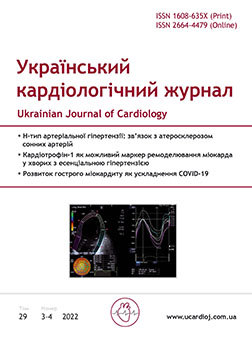Cardiotrophin-1 as a possible marker of myocardial remodeling in patients with essential hypertension, carrying polymorphic variants of the coding gene
Main Article Content
Abstract
The aim – to improve the diagnosis of left ventricular remodeling in patients with essential hypertension (EH) by determining the concentration of cardiotrophin-1 (CT-1) in plasma in carriers of polymorphic variants of the CT-1 gene (rs8046707).
Materials and methods. The study included 100 men aged 40–60, residents of Podillya with EH of varying severity. The first group included patients with stage II EH with a mean age of 50.62±0.73 years, and the second group included patients with EH complicated by chronic heart failure (CHF) with a mean age of 51.86±0.81 years. Structural and functional parameters of the myocardium were evaluated using ultrasound of the heart. Polymorphism of the CT-1 gene (rs8046707) was determined by the polymerase chain reaction method. Determination of the concentration of CT-1 was performed by enzyme-linked immunosorbent assay. Statistical analysis of the results was performed using the software package Statistica 10.0. All tests were bilateral, statistically significant differences were considered at p<0.05.
Results and discussion. Carriers of GA+AA genotypes – 65.00 % (n=65) are significantly more often registered in men with EH of different severity than in GG genotype – 35.00 % (n=35) (p<0.05). It was found that in carriers of any polymorphic variant of the CT-1 gene, men with left ventricular hypertrophy (LVH) and chronic heart failure on the background of EH, concentric left ventricular hypertrophy (LVH) is most common. At the same time, the plasma level of CT-1 in EH is not only higher at higher left ventricular myocardial mass, but is also associated with the carrier of a certain variant of the coding gene. In particular, at EH the level of plasma concentration of CT-1 in eccentric left ventricular hypertrophy (ELVH) is probably higher in carriers of GA+AA genotypes of CT-1 gene (p<0.05). In EH with CHF, regardless of the polymorphism of the CT-1 gene, the concentration of this peptide in blood plasma in different variants of LV hypertrophy is higher than in patients with EH stage II (p<0.05).
Conclusions. Thus, concentric LVH was significantly more common in men with EH stage II and EH with CHF carriers of polymorphic variants of the CT-1 gene. Men with stage EH II carriers of GA+AA genotypes had significantly higher levels of CT-1 in blood plasma with concentric LV hypertrophy (p<0.05). In the case of the development of chronic heart failure on the background of EH, the level of CT-1 in blood plasma when carrying any variant of the gene encoding it is higher than in EH stage II.
Article Details
Keywords:
References
Бондар В.М., Чернишова К.С. Особливості кардіоремоделювання у пацієнтів з артеріальною гіпертензією та метаболічним синдромом. Актуальні проблеми транспортної медицини: навколишнє середовище; професійне здоров’я; патологія. 2016. № 1. С. 52–60.
Коваленко В.М., Сичов О.С., Долженко М.М. та ін. Рекомендації робочої групи з функціональної діагностики Асоціації кардіологів України та Всеукраїнської асоціації фахівців з ехокардіографії з ехокардіографічної оцінки діастолічної функції лівого шлуночка. Webcardio.org. 2016. URL: http://www.webcardio.org/rekomendatsiji-z-ekhokardioghrafichnojiotsinkydiastolichnojifunktsiji-livogho-shlunochka.aspx.
Колесник М.Ю. Динаміка біомаркерів кардіального ремоделювання кардіотрофіна-1 та анексину v в чоловіків з артеріальною гіпертензією під впливом комбінованої терапії. Актуальні проблеми сучасної медицини: Вісник української медичної стоматологічної академії. 2015. Т. 5, № 1 (49). С. 110–115.
Стрільчук Л.М. Ексцентрична гіпертрофія лівого шлуночка з дилатацією його порожнини та без неї: відмінності клінічних, лабораторних та інструментальних показників. Практикуючий лікар. 2017. № 2. С. 5–7.
González A, López B, Ravassa S, Beaumont J, Zudaire A, Gallego I, Brugnolaro C, Díezet J. Cardiotrophin-1 in hypertensive heart disease. Endocrine. 2012;42:9-17. doi: https://doi.org/10.1007/s12020-012-9649-4.
López N, Díez J, Fortuño MA. Differential hypertrophic effects of cardiotrophin-1 on adult cardiomyocytes from normotensive and spontaneously hypertensive rats. J molecular and cellular cardiol. 2006;41(5):902-13. doi: https://doi.org/10.1016/j.yjmcc.2006.03.433.
López-Yoldi M, Stanhope KL, Garaulet M, Chen XG, Marcos-Gómez B, Carrasco-Benso MP, Santa Maria EM, Escoté X, Lee V, Nunez MV, Medici V, Martínez-Ansó E, Sáinz N, Huerta AE, Laiglesia LM, Prieto J, Martínez JA, Bustos M, Havel PJ, Moreno-Aliaga MJ. Role of cardiotrophin-1 in the regulation of metabolic circadian rhythms and adipose core clock genes in mice and characterization of 24-h circulating CT-1 profiles in normal-weight and overweight/obese subjects. FASEB journal: official publication of the Federation of American Societies for Experimental Biology. 2017;31:1639-49. doi: https://doi.org/10.1096/fj.201600396RR.
Lutz S, Franck O, Böhm A, Machann J, Schick F, Machicao F, Fritsche A, Häring H, Staiger H. Common genetic variation in the human CTF1 locus, encoding cardiotrophin-1, determines insulin sensitivity. PLoS One. 2014; 9(7):e100391. doi: https://doi.org/10.1371/journal.pone.0100391.
Ojji D, Libhaber E, Lamont K, Thienemann F, Sliwa K. Circulating biomarkers in the early detection of hypertensive heart disease: usefulness in the developing world. Cardiovasc diagnosis and ther. 2020;10(2):296-304. doi:10.21037/cdt.2019.09.10.
Pemberton C, Raudsepp S, Yandle T, Cameron VA, Richards AM. Plasma cardiotrophin-1 is elevated in human hypertension and stimulated by ventricular stretch. Cardiovascr res. 2005;68:109-17. doi: https://doi.org/10.1016/j.cardiores.2005.05.014
Song K, Wang S, Huang B, Luciano A, Srivastava R, Mani A. Plasma cardiotrophin-1 levels are associated with hypertensive heart disease: A meta-analysis. J clin hypertension. 2014;16:686-92. doi: https://doi.org/10.1111/jch.12376.
Pemberton C, Raudsepp S, Yandle T, Cameron VA, Richards AM. Plasma cardiotrophin-1 is elevated in human hypertension and stimulated by ventricular stretch. Cardiovasc res. 2005;68:109-17. doi: https://doi.org/10.1016/j.cardiores.2005.05.014.
Song K, Wang S, Huang B, Luciano A, Srivastava R, Mani A. Plasma cardiotrophin-1 levels are associated with hypertensive heart disease: A meta-analysis. J clin hypertension. 2014;16:686-92. doi: https://doi.org/10.1111/jch.12376.
Watanabe T, Konii H, Sato K. Emerging Roles of Cardiotrophin-1 in the Pathogenesis and Biomarker of Atherosclerosis. J. 2018;1(1):94-105. doi:https://doi.org/ 10.3390/j1010010.

